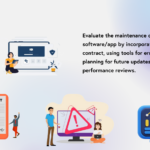Introduction
As a product owner, whether technical or non-technical, one of your biggest fears is seeing your product’s infrastructure collapse under the weight of increasing user demand. We’ve all heard stories about companies that went viral overnight, only to see their platforms crash due to an unprepared infrastructure. It’s a problem that can cost your business both revenue and reputation. But, the good news? You can prevent this.
Scaling your product infrastructure is more than just adding more servers. It’s about creating an environment that dynamically adapts to changing demands, ensuring that your app or software runs smoothly no matter how much traffic it handles.
This guide will walk you through the key strategies to ensure your product can handle high demand without crashing or slowing down. From cloud solutions with auto-scaling to database optimization, we’ll dive into how you can build a scalable and reliable infrastructure.
Why Product Scalability is Crucial
Product scalability isn’t just for tech giants. As your business grows, your user base will naturally expand. If your infrastructure can’t scale with it, you risk frustrating your customers with downtime, sluggish performance, or worse—complete crashes.
Imagine you’ve just launched a marketing campaign that goes viral. Without a scalable infrastructure, all that traffic could be a nightmare rather than a success story. Scalability means you can handle sudden bursts of traffic without compromising user experience or your reputation.
Key Strategies for Scaling Your Product Infrastructure
1. Cloud Solutions with Auto Scaling
One of the most effective ways to ensure your infrastructure scales with demand is by leveraging cloud solutions that support auto-scaling. Cloud platforms such as AWS, Google Cloud, and Azure can automatically adjust the resources allocated to your product based on real-time traffic needs.
Auto-scaling works by adding more servers when traffic spikes and reducing resources during quieter periods, which not only helps you maintain uptime but also optimizes your costs.
Key Benefits:
- Adaptability: Your infrastructure dynamically adjusts to real-time demands.
- Cost Efficiency: You only pay for the resources you use.
- No Downtime: Auto-scaling ensures that your product is always online, even during high demand.

2. Use a Load Balancer to Distribute Traffic Across Servers
When you have a high volume of traffic hitting your platform, a load balancer ensures that no single server is overwhelmed. By distributing the traffic across multiple servers, it improves the overall performance and availability of your product.
Popular load balancers, such as AWS Elastic Load Balancing or NGINX, are easy to set up and critical for maintaining a seamless user experience during traffic surges.
Key Benefits:
- Prevent Overload: Servers won’t be overwhelmed with too many requests.
- Improved Performance: Traffic is distributed efficiently, improving response times.
- Fault Tolerance: If one server fails, the load balancer redirects traffic to other servers.

3. Use a CDN Like Cloudflare or Akamai for Static Content
A Content Delivery Network (CDN) like Cloudflare or Akamai can dramatically reduce the load on your servers by caching static content (such as images, CSS, and JavaScript) closer to users. This results in faster page load times, especially for users located far from your primary server.
CDNs also help in offloading the delivery of static files, making sure your main servers can focus on processing dynamic content and handling user requests more efficiently.
Key Benefits:
- Improved Speed: Cached content is served faster from locations nearer to users.
- Reduced Load: Main servers handle fewer requests, allowing them to focus on critical processes.
- Global Reach: CDNs serve your content to users worldwide with low latency.

4. Ensure Your Database is Well-Indexed
Your database is the backbone of your infrastructure, and if it’s not optimized, it can become a major bottleneck when traffic increases. A well-indexed database ensures that queries are processed quickly, even during high demand.
Consider using techniques such as sharding, read replicas, and proper indexing to enhance your database’s ability to handle large-scale requests. This is especially important if your app relies heavily on data retrieval and manipulation.
Key Benefits:
- Faster Query Responses: Well-indexed databases improve retrieval times.
- Scalability: Your database can handle large amounts of data more efficiently.
- Reduced Latency: Optimized databases reduce delays in processing user requests.

Additional Techniques to Ensure Scalability
1. Microservices Architecture
Adopting a microservices architecture allows you to break your application into smaller, decoupled services that can be scaled independently. This architecture is more flexible than monolithic structures, enabling you to scale only the services that need it, without over-provisioning resources for the entire app.
2. Queuing Mechanisms for Managing Traffic Bursts
Message queuing systems like RabbitMQ or Kafka can help you manage sudden bursts of traffic by queuing tasks and processing them asynchronously. This prevents your system from being overwhelmed by too many requests at once.
3. Stress Testing and Monitoring
Conduct regular stress testing using tools like Apache JMeter to simulate high traffic scenarios and identify potential bottlenecks in your infrastructure. Combine this with real-time monitoring using platforms like Datadog or Prometheus to keep track of your infrastructure’s performance and spot issues before they cause downtime.
4. Graceful Degradation
In the event that your servers can’t keep up with traffic, consider implementing graceful degradation, where non-essential features of your app are turned off to ensure that core functionality remains accessible.
Conclusion: Preparing for Success
Scaling your product’s infrastructure is not a one-time task; it’s an ongoing process. By leveraging cloud solutions, load balancing, CDNs, and database optimization, you can ensure your platform is ready for anything.
Whether you’re preparing for a sudden influx of users or gradual growth over time, a scalable infrastructure will protect your product, your customers, and your bottom line.
Final Thoughts: Scalability as a Growth Strategy
Scalability is more than just handling traffic—it’s about future-proofing your business. By investing in scalable solutions now, you can focus on growth, innovation, and delivering a stellar experience to your users, knowing that your infrastructure can keep up.









